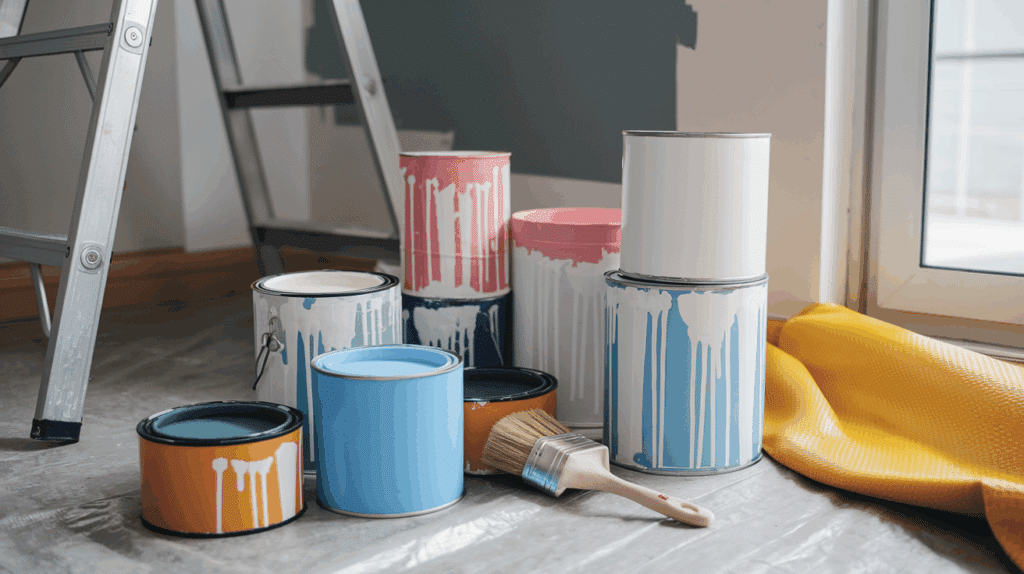Properly storing a 1-gallon (3.8-liter) can of latex or oil-based paint is key to keeping it in great condition for your next project.
I know how frustrating it can be when leftover paint starts to deteriorate before you’re ready to use it again.
Over the years, I’ve learned some simple, yet effective, ways to extend the life of my paint and avoid wasting money on replacements.
If you’re storing extra paint from a recent project or preparing for a future one, following the right storage techniques can keep your paint fresh and ready.
From securely sealing cans to managing the storage temperature, I’ve put together easy steps to help preserve your paint.
By following these tips, you’ll save money and ensure that your paint stays usable for longer.
Why Paint Storage Matters
Storing paint properly keeps it usable and cost-effective, and I want you to get it right. Good storage preserves paint’s quality, ensuring smooth application and a polished look.
When planning paint storage, focus on methods that maintain effectiveness and save money. Here’s what to prioritize:
- Quality Preservation: Proper storage prevents spoilage and clumping.
- Cost Savings: Extends paint life, reducing waste and repurchases.
- Usability: Ensures paint applies evenly for professional results.
- Project Readiness: Keeps paint ready for touch-ups or new projects.
What Affects Paint Shelf Life?

Paint shelf life for a 1-gallon (3.8-liter) can varies based on type, storage conditions, and handling. I’ve helped folks keep paint fresh, and understanding key factors is crucial for longevity.
Proper storage can extend latex paint to 2–10 years or oil-based paint to 5–15 years. You’ll want methods that maintain quality and fit your space. Here are three main factors impacting paint shelf life:
- Paint Type: Latex lasts 2–10 years; oil-based lasts 5–15 years.
- Storage Conditions: Cool, dry spaces prevent spoilage.
- Container Sealing: Airtight lids avoid drying or contamination.
Key Paint Storage Strategies
Storing your 1-gallon (3.8-liter) paint cans correctly can extend their usability, so I’ve outlined some strategies for a typical 10×10-foot (305×305 cm) storage area.
These cover techniques, conditions, and checks to keep paint fresh and effective.
1. Seal Containers Tightly
Airtight sealing of 1-gallon (3.8-liter) cans prevents air exposure, which dries paint or causes clumping.
I’ve seen tightly sealed lids keep latex paint usable for up to 10 years, maintaining its smooth texture.
Use a rubber mallet to secure metal lids or ensure plastic lids snap shut. You’ll love how this simple step keeps your paint ready for flawless application.
- Airtight Lids: Prevent air from drying or spoiling paint.
- Rubber Mallet: Ensures metal lids seal tightly.
- Check Seals: Inspect for gaps to avoid contamination.
2. Store in Cool, Dry Places
Store paint in a cool, dry area, ideally 50–80°F (10–27°C), to maintain its quality. I find a 10×10-foot (305×305 cm) basement or closet ideal, as extreme heat or cold degrades paint.
This keeps both latex and oil-based paints effective for years. You’ll appreciate the consistent quality for your next project.
- Temperature Control: 50–80°F (10–27°C) prevents spoilage.
- Dry Environment: Avoids moisture-related clumping.
- Basement Storage: Stable conditions for long-term use.
3. Avoid Freezing Temperatures
Keep paint above 32°F (0°C) to prevent freezing, which can ruin latex paint’s consistency.
I’ve learned that storing 1-gallon (3.8-liter) cans in a heated garage or indoor shelf avoids damage, especially for water-based paints.
Oil-based paints are more resilient but still benefit from stable temperatures. You’ll value the smooth application that this ensures.
- Above Freezing: 32°F (0°C) minimum for latex paint.
- Heated Storage: Garages or closets protect from cold.
- Stable Conditions: Prevents texture or color changes.
4. Label and Date Cans
Label each 1-gallon (3.8-liter) can with paint type, color, and purchase date to track shelf life.
I recommend using permanent markers or adhesive labels for clarity, helping you use older paint first.
This keeps your 10×10-foot (305×305 cm) storage area organized and efficient. You’ll enjoy the ease of finding the right paint for touch-ups.
- Clear Labels: Note type, color, and date for clarity.
- Use Oldest First: Rotate stock to avoid spoilage.
- Organized Storage: Simplifies project planning.
5. Check Paint Before Use
Test paint before use by stirring and inspecting for lumps, odor, or separation in your 1-gallon (3.8-liter) cans.
I find a quick check ensures that latex or oil-based paint is still effective, saving time on bad batches.
If the paint smells rancid or won’t mix, discard it safely. You’ll appreciate the confidence in using fresh paint for your projects.
- Stir Test: Mix to check for smooth consistency.
- Odor Check: Rancid smells indicate spoilage.
- Safe Disposal: Discard bad paint at local facilities.
Practical Tips for Paint Storage Success
Your paint deserves storage that keeps it fresh and usable, so explore these tips for a 10×10-foot (305×305 cm) storage area. These ideas ensure quality and practicality for your projects.
1. Use Proper Containers
Store paint in original 1-gallon (3.8-liter) cans or airtight plastic containers to maintain quality.
I’ve found original cans with tight lids work best, while transferring to sealed plastic prevents rust for smaller amounts.
This keeps paint fresh and ready for use. You’ll love the reliable results from well-sealed containers.
- Original Cans: Metal lids ensure airtight storage.
- Plastic Containers: Rust-free for small paint amounts.
- Quality Preservation: Prevents air exposure and drying.
2. Store Off the Floor
Keep 1-gallon (3.8-liter) cans on shelves, 12–24 inches (30–61 cm) off the floor, to avoid moisture damage.
I recommend sturdy shelves in a 10×10-foot (305×305 cm) area to protect paint from dampness or spills.
This maintains paint quality and extends shelf life. You’ll appreciate the organized, safe storage setup.
- Elevated Shelves: 12–24 inches (30–61 cm) off the floor.
- Moisture Protection: Prevents damage from damp surfaces.
- Organized Space: Shelves simplify access and storage.
3. Stir Paint Periodically
Stir stored 1-gallon (3.8-liter) cans every 6–12 months to prevent settling or separation.
I’ve seen periodic stirring keep latex and oil-based paints smooth, especially in a 10×10-foot (305×305 cm) storage space.
This ensures even color and texture for future use. You’ll enjoy the consistent quality for your next paint job.
- Regular Stirring: Every 6–12 months for consistency.
- Smooth Texture: Prevents pigment settling or clumping.
- Easy Maintenance: Quick task for long-term quality.
4. Protect from Sunlight
Store paint away from direct sunlight to avoid heat damage, which can degrade 1-gallon (3.8-liter) cans.
I suggest a shaded 10×10-foot (305×305 cm) closet or basement to maintain stable conditions and preserve paint quality.
This keeps your paint vibrant and usable. You’ll value the reliable performance for your projects.
- Shaded Storage: Avoids heat from sunlight exposure.
- Stable Conditions: Maintains paint color and texture.
- Indoor Spaces: Closets or basements work best.
Practical Tips for Maintaining Paint Quality
You deserve paint that stays fresh and usable, so I’m sharing tips for managing your 1-gallon (3.8-liter) cans in a 10×10-foot (305×305 cm) storage area. These strategies ensure long-lasting quality and functionality.
- Monitor Storage Temperature: Keep paint cans at 50–80°F (10–27°C) to preserve quality and avoid spoilage.
- Minimize Air Exposure: Fill cans nearly full or transfer leftovers to smaller containers to keep paint fresh.
- Organize by Paint Type: Separate latex and oil-based paints for easy access and to track shelf life.
- Use Clean Tools for Handling: Always use clean stir sticks and openers to avoid contamination and preserve paint quality.
- Rotate Stock Regularly: Use older paint first by checking dates every 6 months to reduce waste.
Conclusion
When storing 1-gallon (3.8-liter) cans, it’s important to keep them in a cool, dry area with temperatures ranging between 50–80°F (10–27°C).
This helps preserve the paint’s consistency and effectiveness for a long period. Be sure to seal the cans tightly after each use to prevent air from causing deterioration.
Also, labeling the cans with the purchase date and type of paint will help you track their age and avoid confusion when it’s time for your next project.
For latex paints, proper storage can extend the shelf life up to 10 years, while oil-based paints can last even longer, up to 15 years.
Frequently Asked Questions
How Long Can Latex Paint Be Stored?
I find that latex paint in 1-gallon (3.8-liter) cans lasts 2–10 years if stored at 50–80°F (10–27°C) with an airtight seal.
Can Oil-Based Paint Last Longer Than Latex?
Yes, I’ve seen oil-based paint in 1-gallon (3.8-liter) cans last 5–15 years, compared to 2–10 years for latex, with proper storage.
How Do I Know If Stored Paint Has Gone Bad?
I suggest stirring your 1-gallon (3.8-liter) paint; if it’s lumpy, smells rancid, or won’t mix, it’s no longer effective.
Where Should I Store Paint to Keep It Fresh?
I recommend a cool, dry 10×10-foot (305×305 cm) basement or closet at 50–80°F (10–27°C) to keep 1-gallon (3.8-liter) paint fresh.
Can Freezing Ruin Stored Paint?
Yes, freezing below 32°F (0°C) can ruin latex paint in 1-gallon (3.8-liter) cans, but oil-based paint is more resilient to cold.

